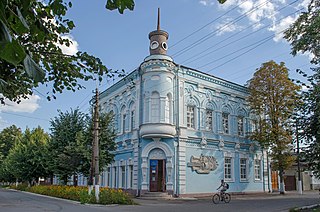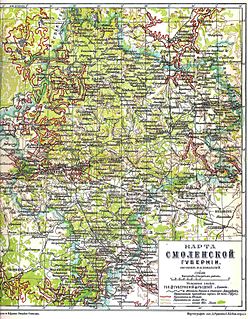
Smolensk is a city and the administrative center of Smolensk Oblast, Russia, located on the Dnieper River, 360 kilometers (220 mi) west-southwest of Moscow.

The Time of Troubles, or Smuta, was a period of political crisis during the Tsardom of Russia which began in 1598 with the death of Fyodor I and ended in 1613 with the accession of Michael I of the House of Romanov.

The Truce of Andrusovo established a thirteen-and-a-half year truce, signed in 1667 between the Tsardom of Russia and the Polish–Lithuanian Commonwealth, which had fought the Russo-Polish War since 1654 over the territories of modern-day Ukraine and Belarus.

The modern administrative-territorial structure of Russia is a system of territorial organization which is a product of a centuries-long evolution and reforms.

Smolensk Voivodeship was a unit of administrative division and local government in the Grand Duchy of Lithuania and later the Polish–Lithuanian Commonwealth.

Novhorod-Siverskyi is a historic city in Chernihiv Oblast (province) of Ukraine. It is the administrative center of Novhorod-Siverskyi Raion, though it is incorporated as a city of oblast significance and does not belong to the raion. Novhorod-Siverskyi is situated on the bank of the Desna River, 330 km from the capital, Kyiv. It hosts the administration of Novhorod-Siverskyi urban hromada, one of the hromadas of Ukraine. As of 2021, its population is 12,647.

Hlukhiv or Glukhov is a small historic town on the Esman River. It is a city of regional significance in the Sumy region of Ukraine, just south of the Russian border. Hlukhiv is administratively incorporated as a city of oblast significance. Hlukhiv Municipality includes Hlukhiv and the village of Sliporod. Hlukhiv also serves as administrative center of Hlukhiv Raion but does not belong to the raion. Population: 32,248

The Polish–Russian War of 1609–1618, also known as the Polish–Muscovite War or the Dimitriads, was a conflict fought between the Tsardom of Russia and the Polish–Lithuanian Commonwealth from 1609 to 1618.

Smolensk Governorate, or the Government of Smolensk, was an administrative division of the Tsardom of Russia, the Russian Empire, and the Russian SFSR. It existed, with interruptions, between 1708 and 1929.

Pochep is a town and the administrative center of Pochepsky District in Bryansk Oblast, Russia, located 84 kilometers (52 mi) southwest of Bryansk, the administrative center of the oblast. Population: 17,161 (2010 Census); 17,064 (2002 Census); 16,868 (1989 Census).

Demidov is a town and the administrative center of Demidovsky District in Smolensk Oblast, Russia, located on the Kasplya River at its confluence with the Gobza River. Population: 7,333 (2010 Census); 8,786 (2002 Census); 10,198 (1989 Census). It was previously known as Porechye.

The Russo–Polish War of 1654–1667, also called the Thirteen Years' War and the First Northern War, was a major conflict between the Tsardom of Russia and the Polish–Lithuanian Commonwealth. Between 1655 and 1660, the Swedish invasion was also fought in the Polish–Lithuanian Commonwealth and so the period became known in Poland as "The Deluge" or Swedish Deluge.

Belarusians are a major ethnic group in Russia. At the census of 2010, 521,443 Russian citizens indicated Belarusian ancestry. Major Belarusian groups live in the regions of Moscow, St. Petersburg, Kaliningrad, Karelia. Most Belarusians in Russia are migrants from modern Belarus or their descendants, while a minor part of Belarusians in Russia are indigenous.
The Muscovite–Lithuanian Wars were a series of wars between the Grand Duchy of Lithuania, allied with the Kingdom of Poland, and the Grand Duchy of Moscow, which would later become the Tsardom of Russia. After several defeats at the hands of Ivan III and Vasily III, the Lithuanians were increasingly reliant on Polish aid, which eventually became an important factor in the creation of the Polish–Lithuanian Commonwealth. Before the first series of wars in the 15th century, the Grand Duchy of Lithuania controlled vast stretches of Eastern European land, from Kyiv to Mozhaysk, following the collapse of Kievan Rus' after the Mongol invasions. Over the course of the wars, particularly in the 16th century, the Muscovites expanded their domain westwards, taking control of many principalities.

The Principality of Smolensk was a Kievan Rus' lordship from the 11th to the 16th century. Until 1127, when it passed to Rostislav Mstislavich, the principality was part of the land of Kiev. The principality gradually came under Lithuanian influence and was incorporated into the Grand Duchy of Lithuania in 1404. The principality was reorganized into the Smolensk Voivodeship in 1508. The Grand Duchy of Moscow controlled the city from 1514 to 1611, then it was recaptured by the Polish–Lithuanian Commonwealth. Tsardom of Russia recaptured the city in 1654.

Glinkovsky District is an administrative and municipal district (raion), one of the twenty-five in Smolensk Oblast, Russia. It lies in the center of the oblast and borders with Dorogobuzhsky District in the northeast, Yelninsky District in the southeast, Pochinkovsky District in the southwest, and with Kardymovsky District in the west. The area of the district is 1,225.74 square kilometers (473.26 sq mi). Its administrative center is the rural locality of Glinka. Population: 4,948 ; 6,149 (2002 Census); 7,866 (1989 Census).

The Siege of Smolensk of 1514 took place during the fourth Muscovite–Lithuanian War (1512–1520).
The following is a timeline of the history of the city of Kharkiv, Ukraine.
The following is a timeline of the history of the city of Pskov, Russia.
The following is a timeline of the history of the city of Voronezh, Russia.
Grand Duchy of Lithuania 1387–1514
Grand Duchy of Moscow 1514–1547
Tsardom of Russia 1547–1618
Polish–Lithuanian Commonwealth 1618–1667
Tsardom of Russia 1667–1721
Russian Empire 1721–1917
Belarusian People's Republic 1918–1919
Soviet Russia 1919–1922
Soviet Union 1922–1941
Nazi Germany 1941–1943
Soviet Union 1943–1991
Russian Federation 1991–present















